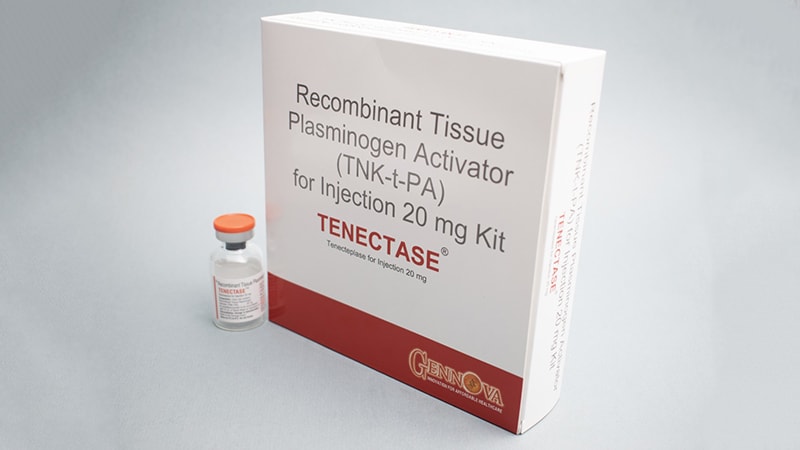Patients with an ischemic stroke treated with tenecteplase have almost a 50% lower rate of symptomatic intracranial hemorrhage (sICH) compared with those receiving alteplase, preliminary results from a large, multicenter registry study suggest.
“In clinical practice where centers are using tenecteplase, we’re seeing that the rate of symptomatic hemorrhage after getting a thrombolytic is half that with tenecteplase than with alteplase,” lead author Steven J. Warach, MD, PhD, professor of neurology at Dell Medical School, University of Texas, Austin, told theheart.org | Medscape Cardiology.
“For clinicians who have switched or are considering switching to tenecteplase, I think these results are very reassuring.”

De Steven Warach
Tenecteplase (TNK) is a relatively new agent that is approved by the US Food and Drug Administration to treat myocardial infarction but not ischemic stroke, although clinicians sometimes use it off-label for this purpose. American Heart Association (AHA) guidelines recommend tenecteplase might be reasonable to consider for ischemic stroke in select patients.
The current standard of care for stroke is alteplase (ALT), which has been approved for this indication since 1996.
Five randomized clinical trials comparing the two thrombolytics weren’t large enough to make definitive conclusions about differences, said Warach. “The event rate for serious bleeding into the brain was thankfully low in both groups.”
Results from a meta-analysis that combined data from those five trials were also not definitive. “Numerically, it looked like the rate was lower for tenecteplase, but the sample size was just too low to make any statistically confident statement.”
However, TNK has practical advantages over ALT. It’s a single bolus injection lasting five seconds while ALT is administered by injection followed by an hour-long infusion.
Given these potential advantages, some centers changed their practice and started using the newer drug beginning in July 2018.
The current study used an ongoing large registry to compare rates of sICH in patients treated with either of these drugs. The registry includes data collected July 2018 to June 2021 from various hospitals and programs in New Zealand, Australia, and the US.
Symptomatic ICH was defined as a severe bleed causing pressure on the brain, extensive swelling and worsening by at least four points on the National Institutes of Health Stroke Scale (NIHSS).
Researchers abstracted data from the various registries. As not all centers record data in the same format, statisticians then “cleaned” or harmonized the data to make it more standardized, said Warach.
They controlled for factors known to put a patient at higher risk for symptomatic hemorrhage, including age, sex, baseline NIHSS, and time to treatment.
Warach noted that at baseline, the TNK group had higher values on most of these factors “that would predict intracranial hemorrhage.”
In an earlier analysis of 7891 patients, the TNK group was older (73 vs 70 years; P < .001), less likely to be female (44.1% vs 48.7%; P = .001), and had higher NIHSS scores (9 vs 7; P < .001).
Also, a greater percentage of those in the TNK group underwent mechanical thrombectomy (36.7% vs 18.0%; P < .001). Warach explained that some centers would opt for TNK if they knew the patient was a candidate for thrombectomy “because that was where the data was clearly strong and positive.”
An updated analysis included 9238 patients — 7313 who received ALT and 1925 TNK. In the updated unadjusted analysis, the sICH rate was 3.6% for ALT and 1.8% for TNK (odds ratio [OR] 0.49; P < .001). The adjusted OR was 0.42 (P < .001.)
The difference was even greater in those who underwent thrombectomy. For patients undergoing this procedure after a thrombolytic, the sICH rate was 5.9% for ALT and 2.4% for TNK.
“That even in those higher-risk patients we’re seeing an even greater difference is promising,” said Warach.
Warach and his colleagues plan to assess other potential benefits of tenecteplase, for example, the time it takes for patients to recover, “once we have all the data standardized and cleaned.”
Results of three large phase 3 trials comparing the two thrombolytics are expected within the next year or two, said Warach.
Joseph Broderick, MD, professor and director of the UC Gardner Neuroscience Institute, director of the National Coordinating Center for NIH’s StrokeNet, and professor of medicine at the University of Cincinnati College of Medicine, Cincinnati, Ohio, stressed that for both drugs, speed is of the utmost importance to protect the brain.
“No matter which of these drugs is going to be used, the key thing is that they have to be used as quickly as possible,” he said.
Also important is imaging the brain before administering either of these medications to ensure the issue is an ischemic stroke and not an intracerebral hemorrhage, said Broderick. “If you have a broken blood vessel, you want to seal the leak, not break up the clot and make the bleeding worse.”
Warach receives payment as chair of the safety committee of another Genentech study comparing tenecteplase vs placebo in patients with large vessel occlusion whose stroke began more than 4.5 hours before treatment.
International Stroke Conference 2022: Presentation 43. Presented February 9, 2022.
For more from theheart.org | Medscape Cardiology, join us on Twitter and Facebook
Source: Read Full Article
